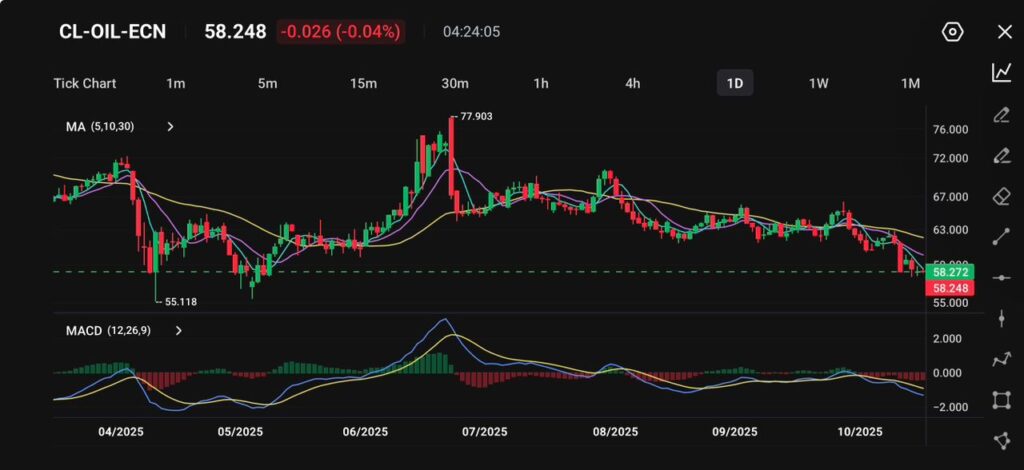
Key Points
- WTI crude rose 0.94% to $58.82, while Brent gained 0.92% to $62.48.
- The IEA expects a record surplus of 4 million barrels per day next year.
Oil prices inched higher in early Asian trading on Thursday, lifted by lingering supply concerns that countered the International Energy Agency’s (IEA) projection of a record 4 million barrels per day surplus in 2026.
The front-month WTI crude contract climbed 0.94% to $58.82 per barrel, while Brent crude rose 0.92% to $62.48 per barrel, extending a modest rebound from earlier lows this week.
Output Struggles Temper Surplus Fears
Although the IEA’s latest outlook points to the largest annual surplus on record, market sentiment remains supported by signs that OPEC+ output continues to lag behind official quotas.
The alliance has underproduced this month, with some members implementing compensatory cuts to offset earlier overproduction, while others are hampered by years of underinvestment that have limited their effective production capacity.
This shortfall in actual supply has cushioned prices from steeper declines, even as expectations for higher global inventories build.
Technical Analysis
Crude oil (CL-OIL) is trading near $58.25, slipping another 0.04%, as markets continue to digest weaker demand forecasts and resilient global supply.
The sustained downturn reflects broader pessimism about global growth, with both the International Energy Agency (IEA) and OPEC cutting demand outlooks this month.
A stronger U.S. dollar and fading geopolitical risk premium have also contributed to the commodity’s bearish tone.

Technically, crude remains under firm bearish pressure. The price continues to trade below its 5-, 10-, and 30-day moving averages, showing clear short-term weakness. The latest failed rebound near $63.00 confirms that resistance remains heavy at that level, while support near the multi-month low of $55.00 is being retested.
A clean break below this zone would expose further downside toward $52.00, whereas a recovery above $60.00 would be needed to shift sentiment back toward neutral.
The MACD indicator reinforces the bearish view, with the histogram extending into negative territory and both the MACD and signal lines trending downward. This indicates that selling momentum remains intact, with no clear sign of reversal yet.
Outlook
Oil markets are likely to remain range-bound as traders navigate between the IEA’s surplus projections and real-time supply constraints within OPEC+.
In the near term, price stability above $58 per barrel could indicate consolidation before the next directional move, while broader momentum will depend on demand signals from China and the trajectory of US economic policy.









